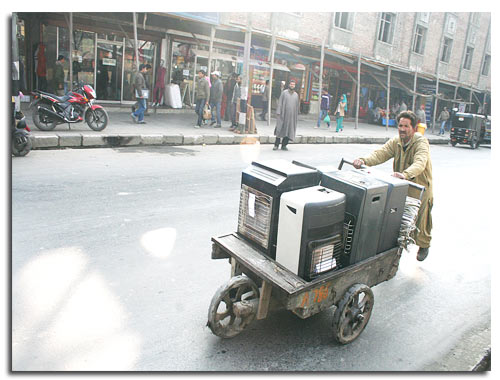Come winter and a wide range of heating appliances fill the markets in Kashmir. While innovation in heating technology has brought variety to the winter market with new equipment slowly replacing the traditional means of beating cold, nothing can beat the magic of Kangri, Syed Asma reports.

While Delhi recently raised the cap for LPG from six to nine cylinders per household from April this year, the LPG crisis persists in Kashmir valley. Over the last few years, gas heaters helped people to brave the cold with almost all classes of people using these heaters to keep themselves warm. But ever since the Centre restricted the number of gas cylinders and sought fresh registration of gas connections, the sale of LPG decreased manifold in Kashmir. With it tanked the sales of LPG heating appliances in Kashmir.
“The sales of gas heaters in the market have gone down by 40-50 percent since the new ruling came out,” Yasin Khan, Chairman, Kashmir Economic Alliance, told Kashmir Life. Anwar Naqasbandi seconds Khan’s view, claiming that the restriction on the usage of LPG has brought a change in the winter market as well. Naqashbandi is an entrepreneur in Srinagar and works as a direct dealer of a branded electronic appliance company. He says the decline in sales of LPG heating appliances has risen the sales of other appliances.
“Shortage of LPG has increased the sale of split/window air conditioners by at least 200 percent this year,” says Naqashbandi. He says offices and commercial buildings used to prefer gas heaters till last year, “But now the new offices and commercial buildings prefer to install split air conditioners. People are investing Rs 60,000-70,000 and purchasing them on a large scale,” he says.
Besides, the sales of oil heaters and electric blankets have more or less remained the same as last year. Urfi Mushtaq Shonthu, an entrepreneur, says the sales of his new products have increased significantly. From time to time, he has introduced new insulating appliances in winter and was first to introduce the concept of central heating system in Kashmir in 1996.
One of Shonthu’s products that he claims is receiving an overwhelming response is the wooden fire place that costs about Rs 20,000 to Rs 60,000. He says he sells the fire place which is the most sought-after product in Kashmir these days across north India.
Under-floor heating system either works on radiators or water pipes which are fitted under the floor. It works on electricity, diesel or LPG. “This year, the sales are up by 15-20 percent. Other than these, under-floor heating system for domestic use is also getting common in Kashmir,” he says. Under-floor heating system is the latest improvisation of traditional hamaams in Kashmir. Due to the lethargic nature of people, the improvised floor heating system works as it does not ask for a laborious job as in traditional hamaam which works on firewood.
“Using LPG is a costly affair and the appliances working on electricity need continuous power supply which is not possible in Kashmir. The floor heating system works on diesel and is the most successful in Kashmir,” Shonthu says.
Majid Wafai, an entrepreneur who has been associated with this business from the last 10 years says the people of valley managed the LPG crisis quietly and switched over to other options. “By nature we are good crisis managers. We didn’t react overtly to this crisis yet and started looking for other options. In many cases, people have switched over to traditional systems like Kangris and Hamaam,” Wafai says.
Wafai says the use of central heating system in commercial establishment has increased over the years. “New hospitals, hotels and offices prefer central heating system these days. Earlier we weren’t ready to invest in this sector but the times are changing slowly and people are investing in their comforts as well. I suggest each one of us to have well insulated walls which does not cost more than Rs 30,000-40,000 on an average,” he says.
All these products are affordable to a select class of people while the rest still survive on the traditional means of warmth in Kashmir – Kangri. Believed to be an improvisation of an Italian product, ‘Scaldino’, Kangri has been a constant shield against biting cold in all these centuries.
There have been many innovations and improvisations of other existing heating appliances but none has been able to replace Kangri. Filled with embers, Kangri is an earthen firepot covered with woven wicker. Different places in Kashmir over the years have improvised on its design and are known for its uniqueness. Kangris from Bandipora and Chrari Sharief are the most famous.
Kangri as a heating appliance, says Shonthu, is very economical. “I want to offer Kangri to the rest of the north India as well because every year many people are killed there by the cold wave. Kangris are affordable and can save them from the winters,” he says.















